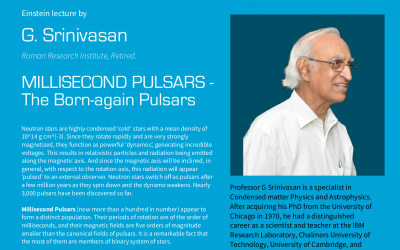Neutron stars are highly condensed ‘cold’ stars with a mean density of 1014 g cm-3. Since they rotate rapidly and are very strongly magnetized, they function as powerful ‘dynamos’, generating incredible voltages. This results in relativistic particles and radiation being emitted along the magnetic axis. And since the magnetic axis will be inclined, in general, with respect to the rotation axis, this radiation will appear ‘pulsed’ to an external observer. Neutron stars switch off as pulsars after a few million years as they spin down and the dynamo weakens. Nearly 3,000 pulsars have been discovered so far.
Millisecond Pulsars (now more than a hundred in number) appear to form a distinct population. Their periods of rotation are of the order of milliseconds, and their magnetic fields are five orders of magnitude smaller than the canonical fields of pulsars. It is a remarkable fact that the most of them are members of binary system of stars.
Millisecond pulsars are of great contemporary interest for several reasons. (1) It has recently been discovered that they are powerful gamma ray emitters. (2) They are potential sources of gravitational waves. (3) Because they are extremely stable ‘clocks’, there is an attempt to use a network of such pulsars as detectors of low frequency gravitational waves.
This lecture will discuss all these aspects, and also the now well accepted scenario for the origin of these ultrarapid pulsars.



